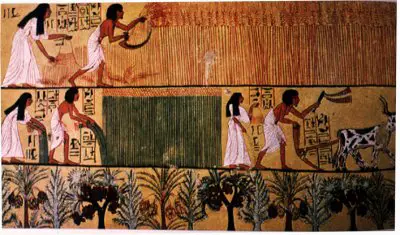The people of ancient Egypt were, to a great extent self-sufficient. The proximity to the Nile river and its frequent flooding were advantageous to farming. Egyptian Farming was one of the principal reasons for their prosperity. They were one of the first groups on earth to begin farming, probably around 10,000 BC.
Egyptian Farming Crops
 Most of the villagers were farmers. Some lived in towns too. Crops like barley, vegetables, figs, melons, pomegranates and vines wheat, barley, flax, onions, leeks, garlic, beans, lettuce, lentils, cabbages, radishes, turnips, grapes, figs, plums and melon.
Most of the villagers were farmers. Some lived in towns too. Crops like barley, vegetables, figs, melons, pomegranates and vines wheat, barley, flax, onions, leeks, garlic, beans, lettuce, lentils, cabbages, radishes, turnips, grapes, figs, plums and melon.
The most important crop was grain. Bread, Porridge and Beer were made of grain. It was the first crop grown after inundation.
Once the grain was harvested, they grew vegetables such as onions, leeks, cabbages, beans, cucumbers and lettuce. Crops were grown along the banks of the Nile which had rich black soil. Farmers planted fruit trees and vines along paths, to give shade as well as fruits. The seasons were dependant on the cycles of river Nile.
There were three seasons
Akhet
It was the flooding season from June- September. The water, mud and silt from the river were washed up over the river banks creating a fertile growing area. All the fields were flooded during this time and naturally farming did not take place. Farmers took to other jobs during this season. People went around in boats.
Peret
It was the growing season from October to February. When floods receded, farmers ploughed the soil ready for farming. They had large ploughs pulled by oxen and hand ploughs
Shemu
Shemu was the harvesting season from March to May. The fully grown crops were cut down and removed before the next flooding season. Reapers cut the ripe corn with wooden sickles edged with sharp flints. Women and children followed behind the reapers to collect any fallen ears of corn.

Cattle were used to trample over the cut corn to remove the grain from the ears. Then the grain was tossed into the air so the breeze blew the light useless chaff away. Simple farming tools such as winnowing scoops, hoes, rakes, flint-bladed sickles and ploughs were used by Egyptians.
For watering crops, canals were used. Shaduf was a piece of equipment used by farmers. A shaduf is a large pole balanced on a crossbeam, a rope and bucket on one end and a heavy counter weight at the other.
By pulling the rope it lowered the bucket into the canal. The farmer then raised the bucket of water by pulling down on the weight. He then swung the pole around and emptied the bucket onto the field.
The majority of the tools were made entirely out of wood, or a combination of wood and stone.However, metal tools also existed.
Animals were very important to Egyptian farmers. Animals helped them with jobs like trampling in the seeds, pulling the plough, eating unwanted grain or wheat and providing the Egyptians with food and drink. Animals such as cattle, goats, pigs, ducks, cows, and geese were kept.